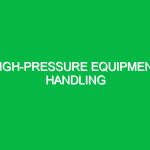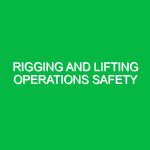Introduction to Occupational Health Hazards in the Oil and Gas Industry
Occupational health hazards in the oil and gas industry are a pressing concern, intertwined with the Health, Safety, and Environment (HSE) domain. This industry, while crucial for energy production, presents unique challenges that can impact the health and safety of its workforce. The potential risks are manifold, stemming from the nature of the work, the environment, and the materials involved. Recognizing these hazards is not merely an administrative task; it is essential for safeguarding workers and ensuring operational efficiency.
With my background in HSE management, I have witnessed firsthand the consequences of neglecting these hazards. From sudden accidents to chronic health issues that develop over years, the stakes are high. In this article, we will delve deep into the various occupational health hazards in the oil and gas sector, explore the risks associated with them, and discuss safety precautions and best practices to mitigate these risks effectively.
Identifying Occupational Health Hazards in the Oil and Gas Industry
Physical Hazards
Physical hazards in the oil and gas industry are among the most prevalent. Workers frequently encounter extreme temperatures, from the heat of drilling sites to the cold of offshore platforms. Exposure to these conditions can lead to heat stress or hypothermia, depending on the circumstances.
Noise is another significant physical hazard. The machinery used in oil extraction and refining generates high noise levels, which can lead to hearing loss over time. Personal protective equipment (PPE), such as earplugs or noise-canceling headphones, is vital in these environments.
Chemical Hazards
Chemical exposure is a serious concern in the oil and gas industry. Workers handle various substances, including hydrocarbons, solvents, and other toxic chemicals. Prolonged exposure to these materials can result in respiratory issues, skin disorders, and even long-term diseases like cancer.
Hydrogen sulfide (H2S) is one of the most dangerous gases encountered. It is colorless and has a strong odor of rotten eggs, but in high concentrations, it can be lethal. Proper training on recognizing the signs of H2S exposure and the use of gas detection systems is crucial.
Biological Hazards
Biological hazards may not be the first thing that comes to mind in the oil and gas industry, but they exist. Workers can be exposed to various pathogens and allergens, particularly when working in remote areas. Issues such as mold, bacteria, and even insect bites can lead to health complications.
Employers must ensure that workers are vaccinated against common diseases and are educated about the risks associated with biological exposure.
Ergonomic Hazards
Ergonomic hazards are often overlooked but can have significant impacts on workers’ health. The oil and gas industry requires physical labor that can result in musculoskeletal injuries. Tasks that involve heavy lifting, repetitive motions, or prolonged awkward postures can lead to chronic pain and injuries.
Implementing ergonomic assessments and providing training on proper lifting techniques can help mitigate these risks.
Safety Precautions and Best Practices
Implementing Comprehensive Training Programs
Training is the cornerstone of safety in the oil and gas industry. Comprehensive training programs that cover the identification of hazards, the correct use of PPE, and emergency response procedures should be mandatory. Regular refresher courses help keep safety protocols fresh in workers’ minds.
I remember a time when a colleague was injured due to a lack of proper training. The incident was a wake-up call for our team, leading to a renewed focus on training and safety awareness.
Utilizing Personal Protective Equipment (PPE)
The use of PPE cannot be overstated. Helmets, gloves, goggles, and respiratory protection are essential to safeguard workers from various hazards. Employers should conduct regular inspections of PPE to ensure it is in good condition and fits properly.
Encouraging a culture where workers feel empowered to use PPE without hesitation is crucial. Everyone needs to feel responsible for their safety and that of their colleagues.
Regular Safety Audits and Inspections
Conducting regular safety audits and site inspections helps identify potential hazards before they result in incidents. These inspections should be thorough and involve all levels of staff, from management to field workers.
During my tenure in the industry, I often participated in safety audits. They not only revealed hidden hazards but also fostered a sense of teamwork and collective responsibility for safety.
Emergency Preparedness and Response Plans
Every oil and gas operation should have clear emergency preparedness and response plans. This includes training on evacuation procedures, emergency medical response, and communication protocols. Regular drills can keep everyone sharp and ready to act in case of an emergency.
I recall an emergency drill that felt tedious at the time, but later proved invaluable when a real emergency occurred. The familiarity with procedures made all the difference in a high-pressure situation.
Promoting Health and Wellness Programs
Beyond immediate safety measures, promoting overall health and wellness can significantly reduce occupational health hazards. Programs focusing on nutrition, mental health, and physical fitness can enhance workers’ resilience against the stresses of the job.
In my experience, when companies invest in their employees’ well-being, they not only improve morale but also reduce absenteeism and enhance productivity.
Regulations and Standards Governing Occupational Health Hazards
The oil and gas industry is heavily regulated to ensure the safety and health of workers. Several key regulations and standards govern occupational health hazards in this sector:
Occupational Safety and Health Administration (OSHA)
OSHA sets forth regulations that establish minimum safety and health standards for workplaces, including the oil and gas industry. These standards cover a wide array of topics, including hazard communication, PPE, and training requirements.
Environmental Protection Agency (EPA)
The EPA regulates environmental impacts and chemical safety, ensuring that oil and gas operations do not harm workers or the surrounding environment. Compliance with EPA standards is crucial for protecting public health as well.
American National Standards Institute (ANSI)
ANSI develops consensus standards that guide safety practices in the workplace. Many companies in the oil and gas sector adhere to these standards to ensure their operations align with best practices in safety.
International Organization for Standardization (ISO)
ISO standards, such as ISO 45001, focus on occupational health and safety management systems. This framework helps organizations proactively improve their health and safety performance, reducing the likelihood of incidents.
Conclusion
Occupational health hazards in the oil and gas industry are complex and multifaceted. From physical and chemical risks to biological and ergonomic hazards, workers face a variety of challenges daily. However, by implementing comprehensive training programs, utilizing appropriate safety equipment, conducting regular audits, and fostering a culture of health and wellness, these risks can be effectively managed.
As someone deeply invested in the HSE domain, I believe that awareness and proactive measures are key. The oil and gas industry is essential to our energy needs, but it must not come at the expense of worker safety. By adhering to regulations and embracing best practices, we can create a safer working environment for everyone involved.


